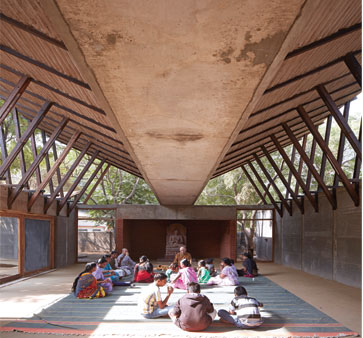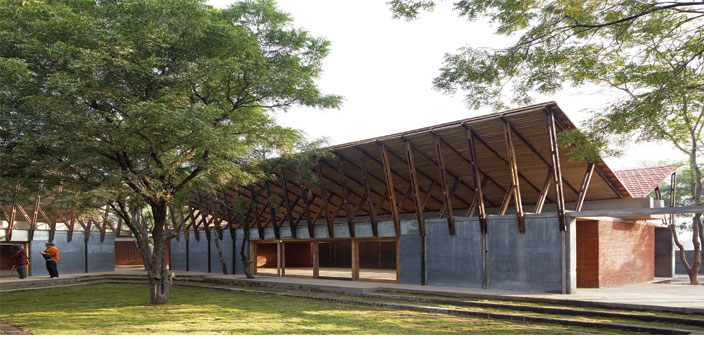Jetavan, the grove of trees where Buddha meditated, is the name given to the Centre in Sakarwadi, near Nashik. It has been built on land donated by the Somaiya Trust and Godavari Refineries, with funds donated by them. Just as the original was a source of enlightenment, this project has thrown up many insights in the process of its execution.
To give a brief introduction, Aparna Dhareshwar and I, are senior architects at Sameep Padora & Associates, a Mumbai-based architectural studio. We have worked on a variety of projects in our 15-odd years, but this one taught us more about community building than all those together.
The institute was programmed to provide a spiritual anchor for the practice of Buddhist thought through meditation and yoga, while also imparting training and skill development for members of the Dalit Baudh community. The community wanted the Centre to be represented by the simplest form of urbanism they aspired to – a concrete (pucca) building with ceramic tile floors.
The indigenous element
Having worked on local materials and labour in our earlier Shiv temple project, we were inclined to have them see the value of indigenous building techniques and materials.
Dr. Supriya Rai, Director, K.J. Somaiya Centre for Buddhist Studies, encouraged our intention to use rammed masonry walls and mud roll timber roofs, while ensuring we kept the project within the stringent budget. The beauty of the project was that not a single existing tree in the premises was cut to make way for the Centre. The six blocks – including the prayer hall, vocational training, administrative and residential units – were designed around the 55 existing trees, enclosing two courtyards, so we could retain “the grove” completely. The roofs are radically different from conventional sloping roofs that slope down from the centre to the walls. Without conventional windows, the natural ventilation happens from the mesh covered space between the roof eaves and wall, also providing lush green views of neem and gulmohar trees in the complex when the eye soars upwards. Post completion in January 2016, the project has been published in several national and international magazines and has won third place in the 2 A Asia Architecture Award 2016 (Public Category) held in Vienna.

(All photos courtesy: Edmund Sumner)
Since we had never used these building techniques before, we collaborated with Hunnarshala Foundation, a Bhuj-based organisation which is propagating local building technology across India. Fly ash-an industrial waste product was available easily in the same factory complex as this building. We jointly studied the other locally available resources and came up with a combination of fly ash and plentiful quarry dust to make rammed masonry walls. The roof truss material came from scrap wood from Alang – the ship breaking yard in Gujarat. Mangalore tiles, discarded from older buildings, were used here. Designers, clients, end users, NGO technical personnel and craftsmen coordinated across geographic, linguistic and ideological differences to construct this unique complex.
Open minds, better buildings
Though they had initially envisaged a brick and RCC structural box, the locals were willing to try this radically different approach of rammed earth and inverted roofs instead. They even agreed to cow dung on the flooring when given the explanation that this was a better option than ceramic tiles, because of its cooling and antiseptic properties. Our stereotype of the inflexibility present in rural mindsets was broken. People everywhere, we realised, are open to good ideas, as long as they can see the value for themselves. They are now wholeheartedly using the centre and are very proud of the attention it is receiving.
The other great learning came from the community of craftspeople who came to teach and execute the rammed masonry walls with Hunnarshala. These people come from Kutch, where natural resources are scarce. In learning and honing new building techniques with Hunnarshala, post the 2001 earthquake, they have shown resilience in developing a more viable future for themselves and their community. Currently, trained construction gangs live for months in unfamiliar surroundings, building and teaching local craftsmen to be self-reliant.
Thirdly, the craftswomen were an eye opener. These women standing shoulder to shoulder with their men, stay on construction sites far from home for many months. Aparna remembers seeing a young mother, effortlessly alternating work with feeding her infant, without slacking off on the job entrusted to her. She says it gave her a new appreciation of how privileged we are, to have the benefit of education and family support to be able to work, but in less trying circumstances.
So, in seeing this project being built, we have observed varying communities in differing circumstances responding in positive ways to change. We learnt that it is in a community’s acceptance of new ideas that progress emerges, gains velocity in the hard work put in by them, and eventually soars above circumstances to prosper and even help others who need a helping hand. And we thought, as the foundation stone was laid, that we would only learn one more new technique of building!


 [/column]
[/column]